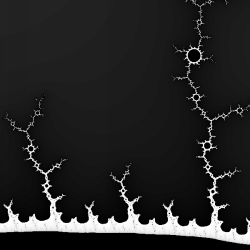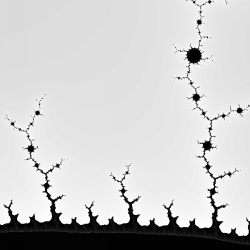|
These two fractals are identical except for the use of slightly different
palettes. They represent a Julia set for a c-value
taken inside a secondary
Mandelbrot set. A secondary Mandelbrot is a mandelbrot that occurs inside
a dendrite coming off the main Mandelbrot. A ternary Mandelbrot would be
inside the dendrite coming out of the secondary Mandelbrot; etc.
Each of the inner circles --- seen inside the dendritic branches below --- could be thought of as a secondary Julia. The vacuole at the bottom of the images is the primary Julia vacuole. Is there a relationship between a secondary (ternary, etc.) Julia and a structure in the Mandelbrot set (say, ternary (quadrary, etc.) ) Mandelbrots? Use XaoS to find out. |


|
-0.000060 < x < +0.000050 :: p = -0.15652 +0.083936 < y < +0.084046 :: q = -1.03225
|